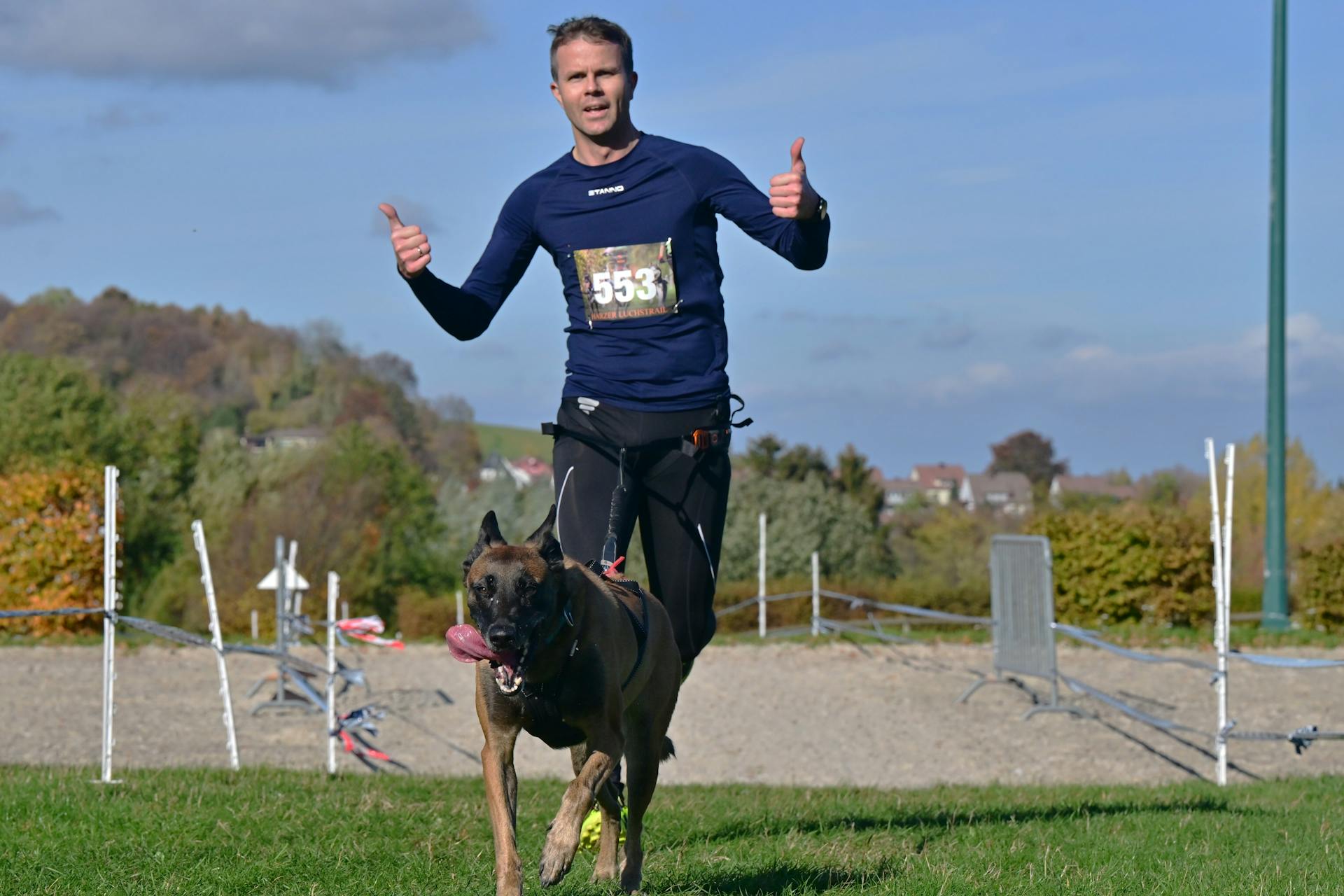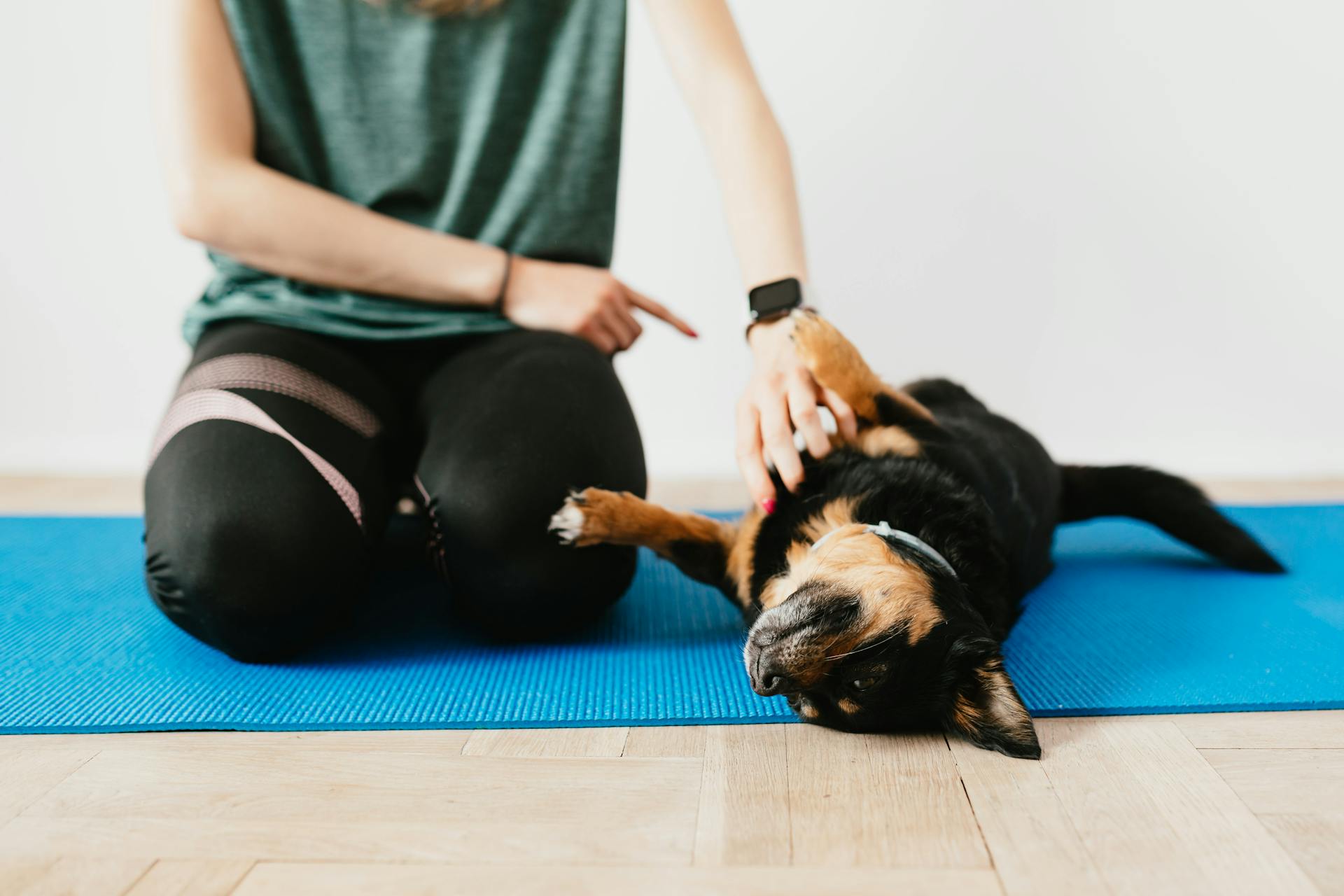
Training your dog is a vital part of their development and can be a fun and rewarding experience for both you and your furry friend.
Positive reinforcement is a powerful tool in dog training, as it encourages good behavior and discourages bad behavior. This approach focuses on rewarding desired actions with treats, praise, and affection.
Consistency is key when training your dog. Dogs thrive on routine and clear boundaries, so establish a regular training schedule and stick to it.
Housebreaking can be a challenging task, but with patience and persistence, your dog can learn to go potty outside.
Getting Started
Getting started with dog sports can be an exciting and rewarding experience for you and your furry friend.
First, you'll want to introduce your dog to dog sports with an introductory session. This will help you both get a feel for what's involved and what to expect.
Canine partners are a great way to get started, and you can even enroll a mixed breed dog in a program if you're not sure what breed you have.
Expand your knowledge: Chow Dog Breed Aggression
You'll also want to learn about titles and abbreviations used in dog sports, so you can understand what your dog's achievements mean.
If you're not sure which sport to try with your dog, consider their age, breed, and energy level. Some sports are better suited for certain dogs than others.
To get started in dog training, you'll need to find a qualified instructor or training program. Look for one that's certified and has experience working with dogs of your breed and age.
Here are some dog sports to consider:
If you can't make it to a physical training session, you can also participate in virtual dog sports and events. These are a great way to stay involved and learn new skills from the comfort of your own home.
Training Fundamentals
Dogs are smart enough to learn the behaviors you want them to have, but they also learn what they can get away with. To train your dog effectively, you need to understand how they learn.
Immediate consequences are all that matter to dogs, just like little kids. They care about what happens right now, not what might happen later.
There are three types of dog intelligence recognized by scientists: instinctive, adaptive, and working and obedience. Instinctive learning is when your dog learns the behaviors they were bred for.
Consistency is key when training your dog. This includes consistency in how you're training them, such as using the same word and intonation when asking them to do something.
To get your dog to be obedient, you should focus on training that uses obedience techniques and specific behaviors you want from them. Both aversive- and reward-based training have been proven to work.
Here are the three types of dog intelligence in a list:
- Instinctive: Breeds learn behaviors they were bred for.
- Adaptive: Dogs learn from their surroundings and environment to solve problems.
- Working and obedience: Dogs learn tasks and commands you teach them.
To avoid confusing your dog, make sure to consistently give them rewards for the behavior you want, and not for the behavior you don't want.
Positive Training Methods
Positive training methods are the way to go, especially if you want to build a strong, loving relationship with your dog.
Almost all vets agree that positive reinforcement training is the most effective method of dog training, as it focuses on rewarding good behavior rather than punishing bad behavior.
Reward-based training uses rewards like treats, praise, and affection to encourage desired behaviors, and it's essential to consistently give your dog rewards for the behavior you want.
If your dog is food-motivated, treats might work better than praise, but if they crave attention, then affection might be the best reward.
To make sure you're not inadvertently rewarding unwanted behavior, wait until your dog is calm before giving them attention.
You should reward your dog immediately after they demonstrate good behavior, so they associate the reward with the desired action.
Some dogs are pickier than others, so try experimenting with different rewards to find what works best for your pup.
If this caught your attention, see: Why Are Dachshunds so Needy
Training treats are great for teaching obedience to puppies through positive reward training, and they can be a lifesaver when teaching your dog new behaviors.
A quiet dog is easy to ignore, but that's the time when you should be praising them, not when they're jumping on you or biting at you.
You might like: Teaching Dog Obedience
Training Techniques
Positive reinforcement is the most effective method of dog training. Almost all vets agree that rewarding good behavior is the way to go.
Aversive-based training uses loud noises, physical corrections, and harsh scoldings, which can create fear in your dog. Reward-based methods use treats, belly rubs, and praise to reinforce good behavior.
Dogs are smart enough to learn what they can get away with, so it's essential to consistently give them rewards for the behavior you want. This means rewarding good behavior immediately, not after the fact.
Use positive reinforcement techniques to focus on rewarding good behavior, rather than punishing bad behavior. This will help your dog associate good behavior with good things.
Broaden your view: Negative Reinforcement Dog Training
Reward your dog with treats, praise, or affection when they perform the behavior you want. Make sure to give them the best reward they want, whether it's food or attention.
Don't reward unwanted behavior, as this can confuse your dog and make them think the bad behavior is good. Wait until they're calm before giving them attention.
Break down complex behaviors into smaller parts and build up in stages. This will help your dog learn more easily and make the training process less overwhelming.
Readers also liked: Reward Based Dog Training
Puppy Training
Puppy training is a crucial part of raising a well-behaved and well-adjusted dog. You can choose between home training and group class training, with each having its own benefits.
Home training allows you to focus more on your dog, making it a great option for those who want a personalized experience. Group class training, on the other hand, helps your dog learn to focus in distracting environments.
A fresh viewpoint: Dog Training Focus Exercises
To effectively train your dog at home, it's essential to consistently reward good behavior with treats, praise, or affection. This will help your dog associate the desired behavior with a positive outcome.
The most effective reward is the one your dog wants the most, so if they're food-motivated, treats might work better than praise.
Some trainers will come to your home for private one-on-one training, while others prefer to train their own dogs. Home training can be beneficial for remote or rural areas where group classes may not be available.
Regardless of the training method you choose, make sure to practice handling and grooming your pup from an early age. This will help your veterinarian and groomer perform their tasks more efficiently and with less stress for your dog.
Here are the five basic commands that every dog should know, as recognized by the American Kennel Club:
- Come
- Heel
- Sit
- Stay
- Down
Common Issues
As we dive into dog training, it's essential to recognize common issues that can arise. One of the most significant problems is that dogs often don't understand what's acceptable behavior in the human world.
Dogs were born knowing only how to be dogs, after all. They need to be taught what's okay and what's not. This is especially true for puppies, but older dogs can learn too.
The key is to start with the basics and establish clear boundaries. By doing so, you can help your dog live successfully in the human world.
A Fearful
Desensitization and counter-conditioning is a powerful technique that helps dogs learn to like the thing they used to be afraid of.
This technique is often used to help dogs overcome fears of fireworks, people, other dogs, and even going to the vet.
Avoiding common mistakes is crucial when trying to help a fearful dog. Two common mistakes people make is not giving the dog enough time to relax and not considering the dog's individual needs.
Eight tips can help a fearful dog feel safe, including getting to know the dog's body language and being patient with the training process.
Management is key to protecting the training you're doing with a fearful dog, and it's essential to use it in conjunction with training.
Three ways management can help with pet behavior issues is by helping the pet cope with difficult situations, understanding their needs, and preventing unwanted behaviors.
Related reading: Training a Fearful Dog
Recognize Common Problems

Your dog was born knowing only how to be a dog, so you must teach him what's acceptable in the human world.
Some common issues that arise from this are problems with basic obedience, such as not listening to commands or pulling on the leash.
Older dogs can learn new behaviors, but it's easiest to teach good habits from the start with a puppy.
If you want your dog to live successfully in the human world, you must first teach him what's acceptable, and this is a lifelong process.
Teaching your dog what's acceptable is a crucial part of their training, and it starts with basic obedience and good habits.
Related reading: Dog Training Basic Obedience Lesson Plan
Frequently Asked Questions
What is the number one rule in dog training?
The number one rule in dog training is to let the dog choose, allowing you to understand and work with their natural behavior. By doing so, you can create a positive and effective training environment.
How many days to train a dog?
Training a dog typically takes 42-63 days, depending on the frequency and duration of sessions. Find out how to optimize your dog's training schedule for the best results.
Sources
- https://www.webmd.com/pets/dogs/dog-training-obedience-training-for-dogs
- https://www.akc.org/expert-advice/training/
- https://www.smalldoorvet.com/learning-center/behavior/top-10-dog-training-tips/
- https://www.companionanimalpsychology.com/p/all-about-dog-training-how-to-train.html
- https://www.akc.org/expert-advice/training/basic-obedience-training-for-your-dog/
Featured Images: pexels.com


